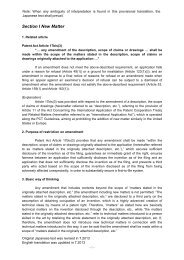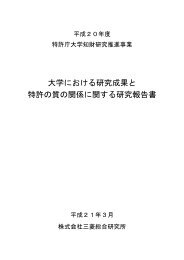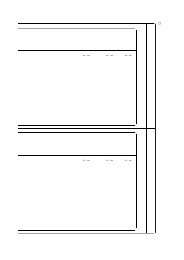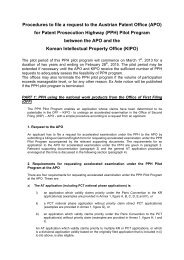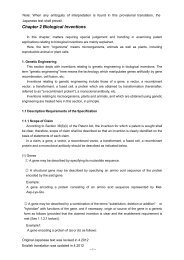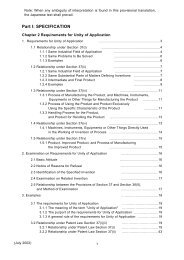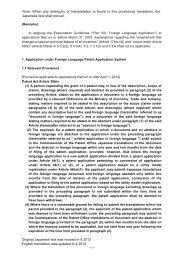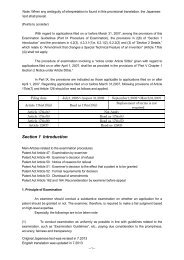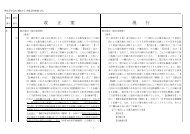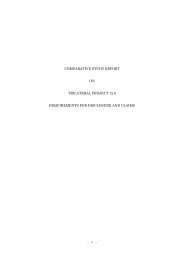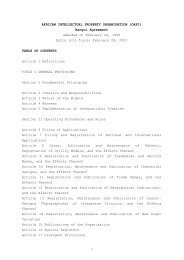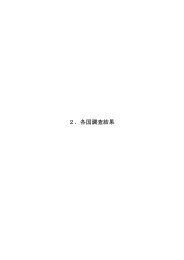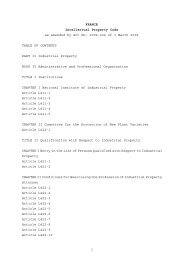Chapter 2 Novelty and Inventive Step - Japan Patent Office
Chapter 2 Novelty and Inventive Step - Japan Patent Office
Chapter 2 Novelty and Inventive Step - Japan Patent Office
Create successful ePaper yourself
Turn your PDF publications into a flip-book with our unique Google optimized e-Paper software.
Part II <strong>Chapter</strong> 2 <strong>Novelty</strong> <strong>and</strong> <strong>Inventive</strong> <strong>Step</strong><br />
bottoms" is a novel use that is derived from a discovered unknown attribute that prevents shells<br />
from sticking to the bottom of ships <strong>and</strong> is not included in the scope of the known arts derived<br />
from the attribute.<br />
[Example 5] "Yogurt containing Ingredient A for use in strengthening bones"<br />
"Yogurt containing Ingredient A for use in strengthening bones" is not food that provides a<br />
novel use since "yogurt containing Ingredient A" <strong>and</strong> the "yogurt containing Ingredient A for use in<br />
strengthening bones" are both provided just as foods even though the invention is derived from<br />
the discovered unknown attribute that promotes your bone to absorb calcium. Therefore, the<br />
novelty of the "yogurt containing Ingredient A for use in strengthening bones" is denied due to the<br />
description "yogurt containing Ingredient A."<br />
In addition, inventions applied as foods, not limited to yogurt, usually do not provide a<br />
novel use that is distinguishable from known foods in light of the common general knowledge in<br />
the food area, even if these known foods provide any discovered novel attributes.<br />
[Example 6] "Cosmetic products containing Ingredient A as an active ingredient for use in<br />
prevention of skin wrinkles"<br />
The invention "cosmetic products containing Ingredient A as an active ingredient for use<br />
in moisture retention of the skin" is derived from an attribute that adjusts the skin by softening the<br />
stratum corneum <strong>and</strong> thus helps the skin to absorb water. On the other h<strong>and</strong>, the invention<br />
"cosmetic products containing Ingredient A as an active ingredient for use in prevention of skin<br />
wrinkles" is derived from an unknown attribute that improves the skin condition by promoting<br />
production of Substance X inside the body. Though they are different in the expressive aspect of<br />
the limitation of use, when the both inventions are applied to the skin for external use as skin-care<br />
cosmetics <strong>and</strong> the common knowledge in the area shows that the cosmetics with a moisturizing<br />
effect are the cosmetics which prevent skin wrinkles etc. for better skin conditions by moisturizing<br />
<strong>and</strong> also applied to prevent skin wrinkles, there are no difference is noted in the use of these two<br />
inventions. Therefore, when there is no difference but the limitation of use between these<br />
inventions, the novelty of the former invention is denied due to the presence of the latter<br />
invention.<br />
Note 1: Generally, when an invention is found to be creative because of the discovery of its<br />
unknown attribute in respect to its purpose of use which is not previously known, it is considered<br />
to be novel as a use invention. Also, the concept of the use invention is generally applied to the<br />
technical fields in which it is relatively difficult to underst<strong>and</strong> how to use the product from the<br />
structure or name of the product, such as the technical field in which compositions containing<br />
chemical substances are used. On the other h<strong>and</strong>, the concept of a use invention is not applied to<br />
machines, instruments, articles, <strong>and</strong> apparatuses because these products are usually used in<br />
fixed manners.<br />
Note 2: The inventive step of the claimed invention is denied when a person skilled in the art<br />
could easily arrive at the use of the product of the invention based on any known attribute or<br />
structures etc. of the product, regardless of the novel use provided based on the attribute.<br />
(Decision by the Tokyo High Court, August 27, 2003 [Heisei 14 (Gyo Ke) 376].)<br />
Note 3: In light of the expressions, some use inventions are described in the style of the limitation<br />
of use as well as the dosage form <strong>and</strong> methods of use. H<strong>and</strong>ling of the above could also be<br />
applied to use inventions described in styles other than those of use limitations, but limited to<br />
inventions whose claims provide certain words for use, such as "catalysts comprising...,"<br />
9



